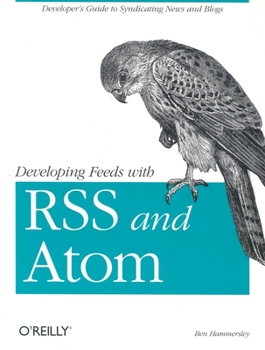Developing Feeds with Rss and Atom
Select Format
Select Condition 
Book Overview
Perhaps the most explosive technological trend over the past two years has been blogging. As a matter of fact, it's been reported that the number of blogs during that time has grown from 100,000 to... This description may be from another edition of this product.
Format:Paperback
Language:English
ISBN:0596008813
ISBN13:9780596008819
Release Date:May 2005
Publisher:O'Reilly Media
Length:253 Pages
Weight:1.00 lbs.
Dimensions:0.7" x 7.0" x 9.2"
Customer Reviews
5 ratings
Get your creative juices flowing
Published by Thriftbooks.com User , 18 years ago
Great intro to the history of RDF/RSS/Atom. Chapter 10 "Unconventional Feeds" will give you great ideas to create and manipulate feeds for yourself. Note that some content has been republished from "Content Syndication with RSS" (0596003838).
Far more practical than Practical RDF
Published by Thriftbooks.com User , 19 years ago
O'Reilly's other book on RSS related technologies, Practical RDF, was not very practical at all. This book, on the other hand, addresses a variety of real feed production and consumption topics in a set of language. You will learn the feed standards. But you will learn them through application, not abstraction. And I find that much more effective than a book that presents technologies at the standards level (most of which you never use anyway). Then leaves you hanging.
All You Need to Publish Using RSS/Atom
Published by Thriftbooks.com User , 19 years ago
RSS/Atom have become the most popular technologies for letting a web site share it's new stuff with other applications. It's basically a set of standardized XML commands that allow other systems out there to pick up your new stuff and spread the word that it's available. At it's simplest, RSS is only a handful of commands that allow you to publish a feed. But this is the computer business and it seems that we strive to make it more complex. RSS split into two factions, both of them rightfully claiming that their way is right -- if you need what their way offers. (At the simple level, they are compatible.) Tired of the unwillingness to compromise a third group has created Atom, a different set of XML commands to essentially do the same things. Totally different of course. One thing this book does is very clearly explain the differences in these various versions and the history about why/how they came about, and a little about where they might be going. At least a third of the book then goes into the other side of RSS, which is how to read an RSS Feed. His examples are given in Perl. I don't use perl, but the important part of the examples are simply that they can be done, i.e. getting Doonesbury automatically every morning or tracking a FedEx package. As with most O'Reilly books, this is the definitive book on the subject, written by a professional programmer for professional programmers. It's all you need on the subject.
A useful little book
Published by Thriftbooks.com User , 19 years ago
This is a useful little book; the whole main content is around 200 pages and the author's pleasant writing style makes it really easy to read in a day or two. The amount of pages isn't huge but, in my opinion, provides an effective coverage of RSS. Most code listings use Perl, making them useless for people (like me) using other languages but this doesn't really affect the book too much, since the goal isn't to provide a collection of coding recipes. This new edition doesn't cover RSS 0.9x anymore but has a nice chapter on Atom
Good General Development Guide
Published by Thriftbooks.com User , 19 years ago
Both individuals who know what RSS/Atom feeds are but need information on how to develop and implement them, as well as intermediate users already publishing a feed and looking for more progressive information, will find value in this title. Advanced users will most likely not find anything they don't already know. Covering RSS 1.0, RSS 2.0 and Atom .05, readers are walked thru the basics and intermediate concepts of implementation starting with a general background history, end-user reader requirements and options, and syntax usage for each version. The book then concludes with more intensive topics, such as usage of industry standard RSS modules, development of custom RSS modules, syndication thru services or direct publication, as well as third-party utility scripts and resources. A few items set this title apart. First, the author has not dedicated this only to those who wish to perform serious syndication. Time is spent both showing how anyone regardless of skill level can publish a feed without programming, and teaching them how to use various styles of feed readers and the etiquette behind subscribing. For those who wish to go beyond basic feed development, the author dedicates entire chapters to things such as RSS modules (by RSS version), programmatically developed feeds, creating feeds which self-publish data from other web sites or databases, and publishing your feed for various platforms. Readers should be aware that the majority of scripts presented within the title are in Perl or PHP, and either a working knowledge of those languages or of any scriptable language will be needed if you intend to go beyond the beginning / intermediate level; not having this knowledge does not detract from the overall value of the book. This title shows that RSS/Atom feeds are not just for the minority any more. Complete chapters are dedicated to all three formats, presenting all material in and easy to read and understand format without wasting your time with fluff or thinly disguised plugs for 3rd party products. This is a good general guide that will maintain value after your initial read.





